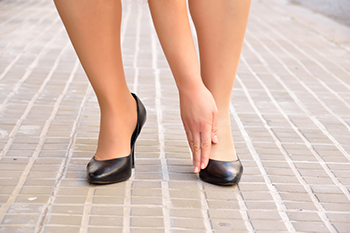Items filtered by date: November 2023
The Right Shoes for Restaurant Employees

In the bustling world of restaurant service, the right choice of footwear is not a style statement, it is a vital component of safety and comfort for employees who work on their feet for extended periods. Non-slip shoes top the list of essentials, offering stability on potentially slippery kitchen floors. These shoes, designed with slip-resistant soles, reduce the risk of accidents in fast-paced environments where spills are common. Comfort is equally important, considering the long hours spent standing and moving swiftly. Opting for shoes with adequate arch support and cushioning can alleviate foot fatigue and contribute to overall well-being. Additionally, shoes with closed toes provide an extra layer of protection against spills and falling objects. Prioritizing functionality over fashion ensures that restaurant employees can navigate their demanding work environments with confidence, focusing on delivering excellent service rather than wrestling with uncomfortable or unsafe footwear. If you are a restaurant employee and are seeking information about what type of shoes to wear, it is suggested that you speak with a podiatrist.
While working on the feet, it is important to take the proper care of them. For more information about working on your feet, contact Donald Manger, DPM from Associated Podiatric Physicians, PA. Our doctor will treat your foot and ankle needs.
Working on Your Feet
Standing on your feet for long periods of time can cause stress and pain in your feet. Your whole body may experience change in terms of posture, back pain, bunions, callouses and or plantar warts. There are ways to avoid these conditions with proper foot care, smart choices and correct posture.
Positive Changes
Negative heeled shoe – Choosing this shoe type places the heel slightly lower than the ball of the foot. These are great for overall foot health. Find shoes that fit you correctly.
Go barefoot – Our feet were not designed to be enclosed for all hours of the day. Try to periodically expose your feet to air.
Eliminate Pain
Foot Exercises – Performing simple exercises, incorporating yoga and doing stretches are beneficial. This will allow increased blood flow to the area and muscles of the foot.
Achilles tendon – Stretching the foot out flat on the floor will relax the calf muscles and tendon. These exercises can be performed almost anywhere. Make sure you add these exercises to your daily regimen.
With a little bit of this information and knowing more about foot health, you will notice changes. Foot stretches and proper footwear will help with pain and prevent further issues.
If you have any questions please feel free to contact our office located in Hamilton Township, NJ . We offer the newest diagnostic and treatment technologies for all your foot and ankle needs.
Avoiding Limb Amputation From Diabetes

In recent years, the United States has witnessed a concerning rise in lower leg, foot, and toe amputations, with 80% attributed to complications from diabetes. Proactive measures such as lifestyle changes, blood sugar management, as well as regular foot examinations and prompt wound care from a podiatrist can help patients avoid this dire solution. Depending on the severity of complications as the result of peripheral artery disease and neuropathy that are common among diabetics, a podiatrist may offer various interventions. Included are wound cleaning, dead tissue removal, revascularization surgery to restore blood flow, and antibiotic treatments for infection. In extreme cases, however, loss of limb may be unavoidable. Scheduling routine foot screenings with a podiatrist and performing daily foot checks at home to catch potential issues early can help to keep the symptoms at bay. Pain or numbness in feet and toes, fungal infections, changes in color, and swollen feet may indicate serious foot problems. Additionally, ingrown toenails, wounds, and sores are symptoms may need immediate attention. If you suffer from diabetic complications that may lead to limb loss, it is strongly suggested that you are under the care of a podiatrist for regular checkups.
Limb salvage can be an effective way in preventing the need for limb amputation. If you have diabetes, cancer, or any other condition that could lead to foot amputation if left unchecked, consult with Donald Manger, DPM from Associated Podiatric Physicians, PA. Our doctor will assess your condition and provide you with quality foot and ankle treatment.
What Is Limb Salvage?
Limb salvage is the attempt of saving a limb, such as the foot from amputation. Podiatrists also try to make sure that there is enough function in the foot after the salvage that it is still usable. Diabetes is the number one cause of non-traumatic amputations in the United States. Those with diabetes experience poor blood circulation, which prevents proper healing of an ulcer. If the ulcer is left uncheck, it could become infected, which could result in the need for amputation.
However, there are other causes as well, such as cancer and traumatic injury. Links between higher mortality rates and amputation have been found. This translates into higher healthcare costs, and a reduced quality of life and mobility for amputees. Podiatrists have attempted to increase the prevalence of limb salvage in an attempt to solve these issues.
Diagnosis and Treatment
Limb salvage teams have grown in recent years that utilize a number of different treatments to save the infected limb. This includes podiatrists that specialize in wound care, rehabilitation, orthotics, and surgery. Through a combination of these methods, limb salvage has been found to be an effective treatment for infected limbs, and as an alternative to amputation. Podiatrists will first evaluate the potential for limb salvage and determine if the limb can be saved or must be amputated.
If you have any questions, please feel free to contact our office located in Hamilton Township, NJ . We offer the newest diagnostic and treatment technologies for all your foot care needs.
Why Walking in High Heels Can Be Challenging

High heels are undoubtedly stylish and add an elegant touch to any outfit, but there is no denying that walking in them can be a daunting task for many. Several things make it difficult to walk gracefully and comfortably in high heels. First, the angle of the foot in high heels forces the wearer to put most of their body weight on the balls of the feet. This shift in weight distribution can lead to instability, causing a precarious and unsteady gait. Second, the elevation of the heel shortens the Achilles tendon and calf muscles, making it challenging to take regular, longer strides. This altered biomechanics can cause discomfort and make walking feel unnatural. Additionally, the pressure and friction created by the narrow, pointed shape of high heels can lead to blisters, calluses, and foot pain. In essence, the difficulty of walking in high heels is not merely a matter of fashion; it is a matter of biomechanics and comfort. For many, it is a skill that requires practice and endurance. So, while high heels can make a powerful fashion statement, they also pose a challenge for those who dare to wear them. If you would like more information on how high heels can affect the feet and better alternatives to consider, it is suggested that you speak with a podiatrist.
High heels have a history of causing foot and ankle problems. If you have any concerns about your feet or ankles, contact Donald Manger, DPM from Associated Podiatric Physicians, PA. Our doctor can provide the care you need to keep you pain-free and on your feet.
Effects of High Heels on the Feet
High heels are popular shoes among women because of their many styles and societal appeal. Despite this, high heels can still cause many health problems if worn too frequently.
Which Parts of My Body Will Be Affected by High Heels?
- Ankle Joints
- Achilles Tendon – May shorten and stiffen with prolonged wear
- Balls of the Feet
- Knees – Heels cause the knees to bend constantly, creating stress on them
- Back – They decrease the spine’s ability to absorb shock, which may lead to back pain. The vertebrae of the lower back may compress.
What Kinds of Foot Problems Can Develop from Wearing High Heels?
- Corns
- Calluses
- Hammertoe
- Bunions
- Morton’s Neuroma
- Plantar Fasciitis
How Can I Still Wear High Heels and Maintain Foot Health?
If you want to wear high heeled shoes, make sure that you are not wearing them every day, as this will help prevent long term physical problems. Try wearing thicker heels as opposed to stilettos to distribute weight more evenly across the feet. Always make sure you are wearing the proper shoes for the right occasion, such as sneakers for exercising. If you walk to work, try carrying your heels with you and changing into them once you arrive at work. Adding inserts to your heels can help cushion your feet and absorb shock. Full foot inserts or metatarsal pads are available.
If you have any questions please feel free to contact our office located in Hamilton Township, NJ . We offer the newest diagnostic and treatment technologies for all your foot and ankle needs.
Plantar Warts Can Be Treated!
All About Foot Blisters

Blisters are fluid-filled pockets that typically form in the skin's upper layers after injury, commonly on feet. The fluid cushions the damaged area, aiding healing. Most blisters contain clear serum and heal naturally in three to seven days without medical intervention. Bursting them should be avoided to prevent infection or delays in healing. If they burst, allow drainage and cover with a sterile dressing. Blisters stem from various causes, including friction, heat, chemical contact, or medical conditions, like chickenpox. Preventing blisters involves wearing comfortable, well-fitting shoes, keeping feet dry with thicker socks or talcum powder, and applying sunscreen. If you have a foot blister that appears infected, is painful, or is recurring, it is suggested that you make an appointment with a podiatrist as soon as possible.
Blisters are prone to making everyday activities extremely uncomfortable. If your feet are hurting, contact Donald Manger, DPM of Associated Podiatric Physicians, PA. Our doctor can provide the care you need to keep you pain-free and on your feet.
Foot Blisters
Foot blisters develop as a result of constantly wearing tight or ill-fitting footwear. This happens due to the constant rubbing from the shoe, which can often lead to pain.
What Are Foot Blisters?
A foot blister is a small fluid-filled pocket that forms on the upper-most layer of the skin. Blisters are filled with clear fluid and can lead to blood drainage or pus if the area becomes infected.
How Do Blisters Form?
Blisters on the feet are often the result of constant friction of skin and material, usually by shoe rubbing. Walking in sandals, boots, or shoes that don’t fit properly for long periods of time can result in a blister. Having consistent foot moisture and humidity can easily lead to blister formation.
Prevention & Treatment
It is important to properly care for the affected area in order to prevent infection and ease the pain. Do not lance the blister and use a Band-Aid to provide pain relief. Also, be sure to keep your feet dry and wear proper fitting shoes. If you see blood or pus in a blister, seek assistance from a podiatrist.
If you have any questions, please feel free to contact our office located in Hamilton Township, NJ . We offer the newest diagnostic and treatment technologies for all your foot care needs.

